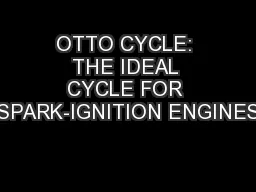

AN OVERVIEW OF RECIPROCATING ENGINES Sparkignition SI engines Compressionignition CI engines Compression ratio In SI engines the compression ratio is limited by autoignition or engine knock ID: 590403
Download Presentation The PPT/PDF document "OTTO CYCLE: THE IDEAL CYCLE FOR SPARK-IG..." is the property of its rightful owner. Permission is granted to download and print the materials on this web site for personal, non-commercial use only, and to display it on your personal computer provided you do not modify the materials and that you retain all copyright notices contained in the materials. By downloading content from our website, you accept the terms of this agreement.
Slide1Slide2Slide3Slide4Slide5Slide6Slide7Slide8Slide9Slide10Slide11Slide12Slide13Slide14Slide15Slide16Slide17
OTTO CYCLE: THE IDEAL CYCLE FOR SPARK-IGNITION ENGINESSlide18
AN OVERVIEW OF RECIPROCATING ENGINES
Spark-ignition (SI) engines
Compression-ignition (CI) engines
Compression ratioSlide19
In SI engines, the compression ratio is limited by
autoignition
or
engine knock
.
19
Thermal efficiency of the ideal Diesel cycle as a function of compression and cutoff ratios (
k=
1.4).
Cutoff ratioSlide20Slide21Slide22Slide23Slide24Slide25Slide26Slide27
Mean effective pressure
The mean effective pressure can be used as a parameter to compare the
performances of reciprocating engines of equal size.
The engine with a
larger value of MEP delivers more net work per cycle and thus performs
better.Slide28
Schematic of a two-stroke reciprocating engine.
The two-stroke engines are generally less efficient than their four-stroke counterparts but they are relatively simple and inexpensive, and they have high power-to-weight and power-to-volume ratios.
Four-stroke cycle
1 cycle = 4 stroke = 2 revolution
Two-stroke cycle
1 cycle = 2 stroke = 1 revolutionSlide29
A
ir
enters the cylinder through the open intake valve at atmospheric pressure
P
0
during process 0-1 as the piston moves from TDC to BDC.
The intake valve
is closed at state 1 and air is compressed isentropically to state 2.
Heat is
transferred at constant volume (process 2-3); it is expanded isentropically to
state 4; and heat is rejected at constant volume (process 4-1).
Air is
expelled through the open exhaust valve
(process 1-0)
.
Work interactions during intake and exhaust cancel each other, and thus i
nclusion of the intake and exhaust processes has
no effect on the net work output from the cycle.
However, when calculating
power output from the cycle during an ideal Otto cycle analysis, we must consider the fact that the ideal Otto cycle has four strokes just like
actual four-stroke spark-ignition engine.Slide30
30
In SI engines, the compression ratio is limited by
autoignition
or
engine knock
.Slide31
DIESEL CYCLE: THE IDEAL CYCLE
FOR COMPRESSION-IGNITION ENGINES
In diesel engines, only air is compressed during the compression stroke, eliminating the possibility of autoignition (engine knock). Therefore, diesel engines can be designed to operate at much higher compression ratios than SI engines, typically between 12 and 24.
1-2
isentropic compression
2-3
constant-volume heat addition
3-4
isentropic expansion
4-1
constant-volume heat rejection.Slide32
Thermal efficiency of the ideal Diesel cycle as a function of compression and cutoff ratios (
k=
1.4).
Cutoff ratio
for the same compression ratioSlide33
BRAYTON CYCLE: THE IDEAL CYCLE FOR GAS-TURBINE ENGINES
The combustion process is replaced by a constant-pressure heat-addition process from an external source, and the exhaust process is replaced by a constant-pressure heat-rejection process to the ambient air.
1-2 Isentropic compression (in a compressor)
2-3 Constant-pressure heat addition
3-4 Isentropic expansion (in a turbine)
4-1 Constant-pressure heat rejectionSlide34
Pressure ratioSlide35
The two major application areas of gas-turbine engines are
aircraft propulsion
and
electric power generation
.
The highest temperature in the cycle is limited by the maximum temperature that the turbine blades can withstand. This also limits the pressure ratios that can be used in the cycle.
The air in gas turbines supplies the necessary oxidant for the combustion of the fuel, and it serves as a coolant to keep the temperature of various components within safe limits. An air–fuel ratio of 50 or above is not uncommon.Slide36
Development of Gas Turbines
Increasing the turbine inlet (or firing) temperatures
Increasing the efficiencies of turbomachinery components (turbines, compressors):
Adding modifications to the basic cycle (intercooling, regeneration or recuperation, and reheating).
Deviation of Actual Gas-Turbine Cycles from Idealized Ones
Reasons:
Irreversibilities in turbine and compressors, pressure drops, heat losses
Isentropic efficiencies of the compressor and turbineSlide37
IDEAL JET-PROPULSION CYCLES
Gas-turbine engines are widely used to power aircraft because they are light and compact and have a high power-to-weight ratio.
Aircraft gas turbines operate on an open cycle called a
jet-propulsion cycle
.
The ideal jet-propulsion cycle differs from the simple ideal Brayton cycle in that the gases are not expanded to the ambient pressure in the turbine. Instead, they are expanded to a pressure such that the power produced by the turbine is just sufficient to drive the compressor and the auxiliary equipment.
The net work output of a jet-propulsion cycle is zero. The gases that exit the turbine at a relatively high pressure are subsequently accelerated in a nozzle to provide the thrust to propel the aircraft.
Aircraft are propelled by accelerating a fluid in the opposite direction to motion. This is accomplished by either slightly accelerating a large mass of fluid (
propeller-driven engine
) or greatly accelerating a small mass of fluid (
jet
or
turbojet engine
) or both (
turboprop engine
).Slide38Slide39
39
Propulsive efficiency
Propulsive power
Thrust (propulsive force)